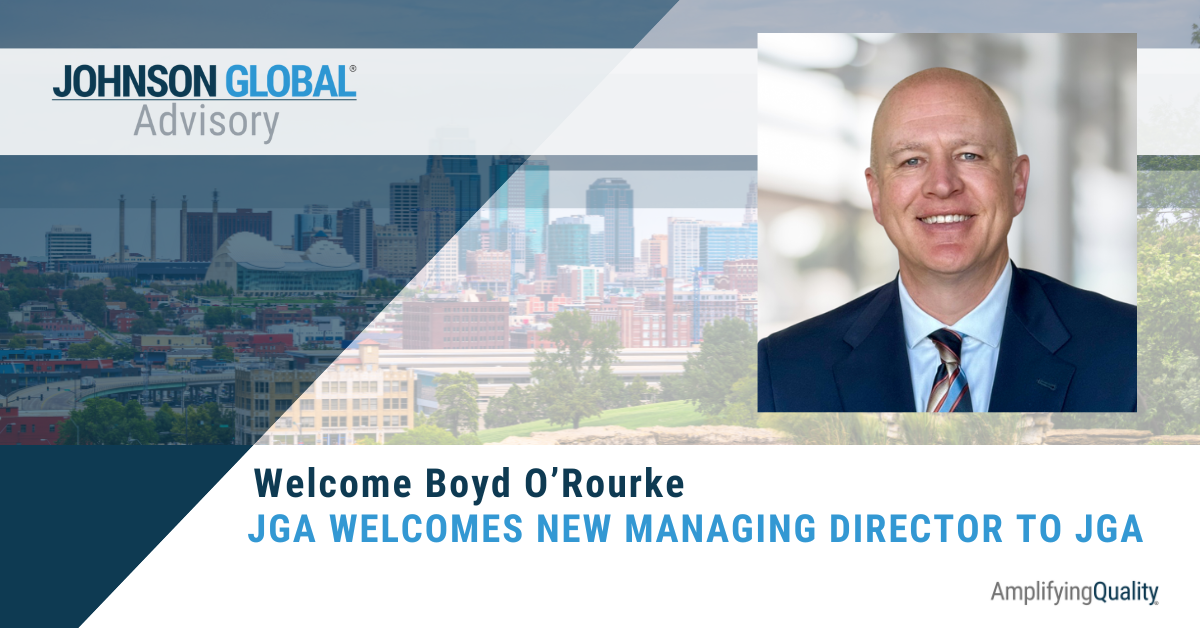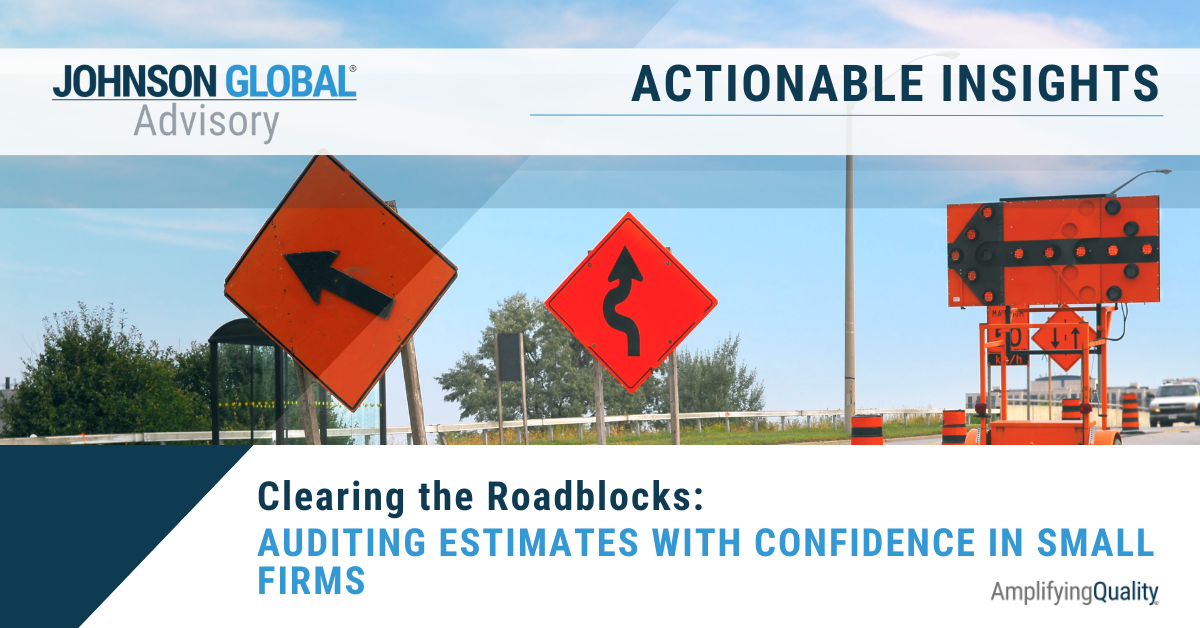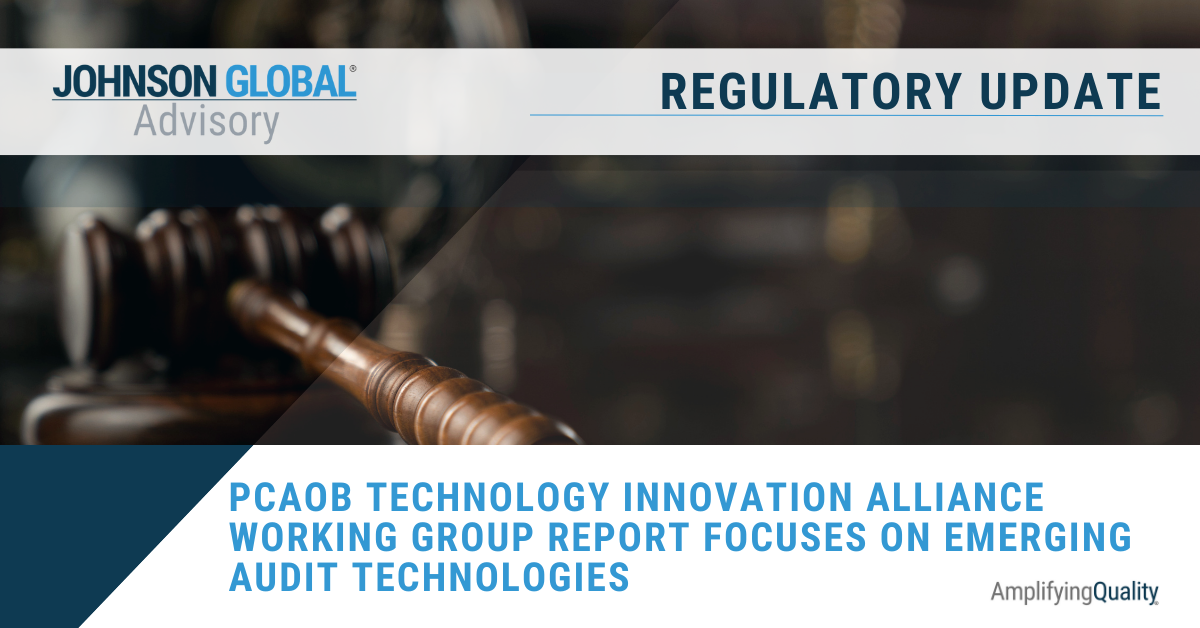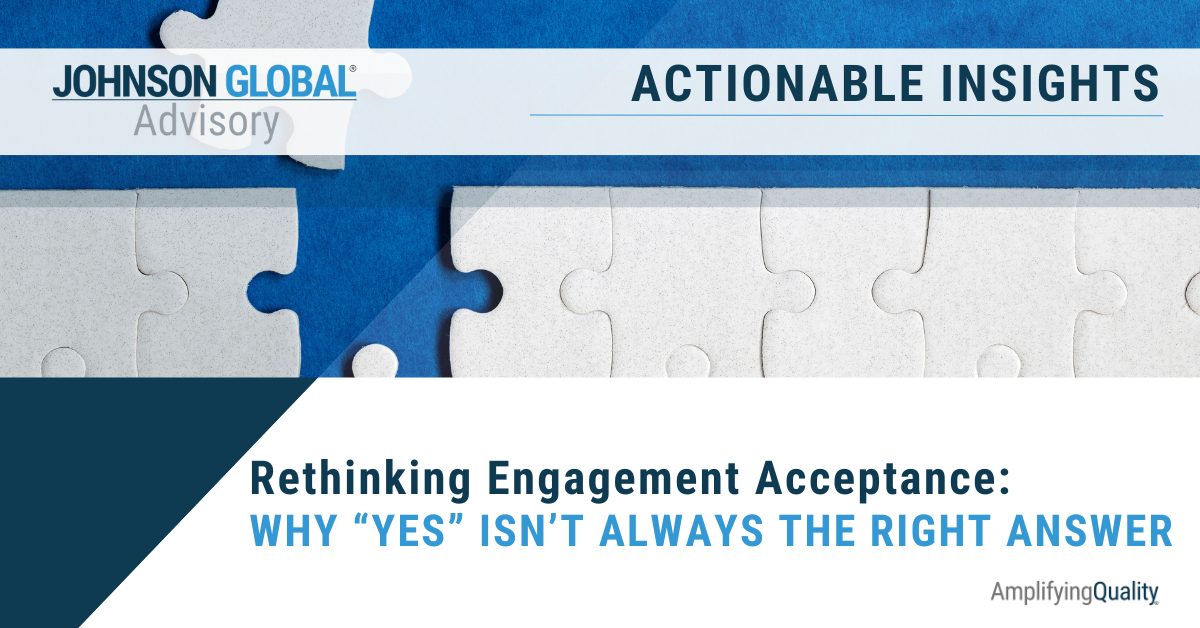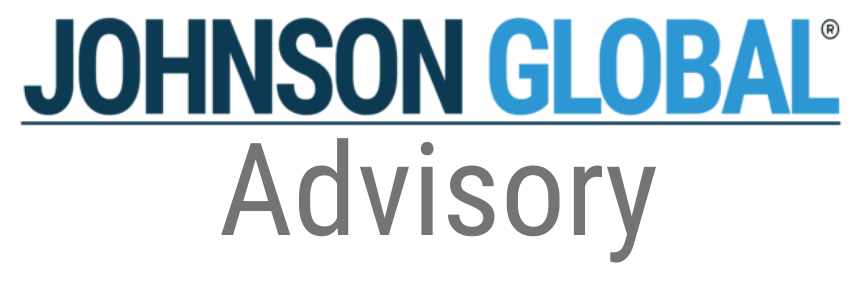An Interview with The Mexican Institute of Public Accountants
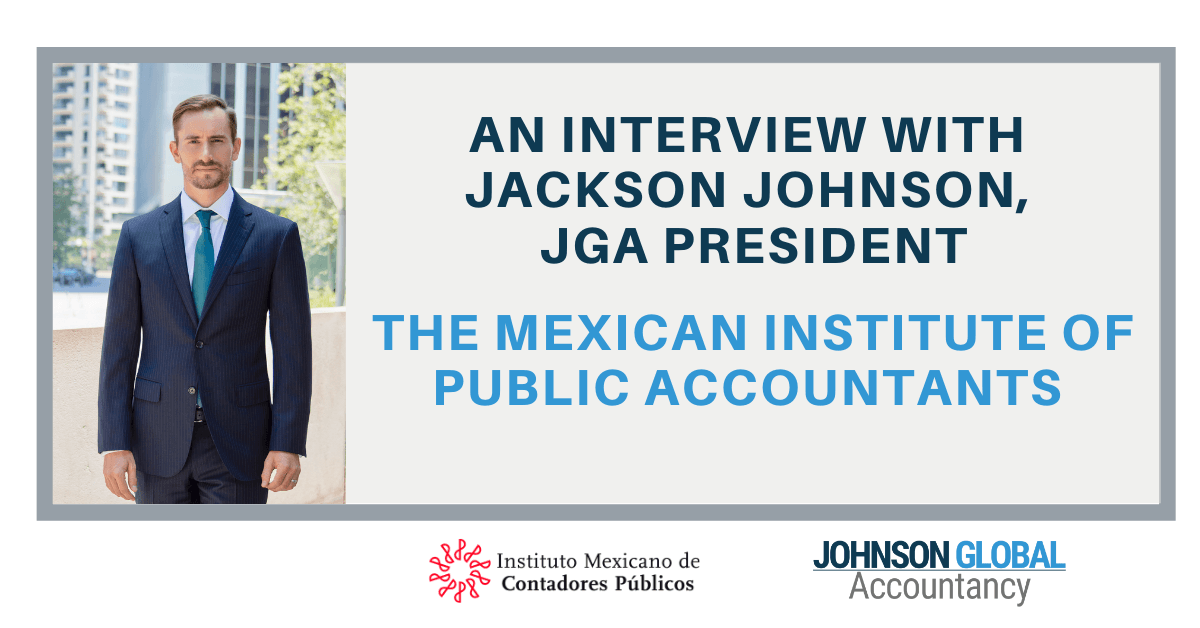
This interview of Jackson Johnson, JGA President, by Rogelio Avalos Andrade C.P.C., Chairman of the Quality Oversight Management Committee, was published in the March 2020 Contaduría Pública from Mexican Institute of Public Accountants.
Download the full article here in both Spanish and English.
Jackson Johnson, Founder and President of Johnson Global Accountancy ("JGA"), a firm that provides advisory services to accounting firms to assist them in quality issues and help them to comply with quality standards, is a Certified Public Accountant in California and Massachusetts and member of the American Institute of Certified Public Accountants. With six years in the Division of Registration and Inspections at the PCAOB, he developed his experience in audits of financial statements at Grant Thornton in Boston, Los Angeles, and the member firm in Hong Kong.
RA: Before I start with my questions to Jackson, we introduced him on how the audit practice in Mexico is being regulated and overseen. The Mexican Institute of Public Accountants (IMCP) oversees the audit and assurance practice from within this membership through its Vice-presidency of quality in the professional practice. This Vice-presidency issued the Standard of Quality Control (basically, identical to the ISQC1) and the Standard of Oversight of Quality Control (NRCC for its Spanish acronym), which sets forth the rules to perform inspections to firms to assess compliance with applicable laws, rules and professional standards in their systems of quality control and the documentation of a selection of completed audit and other attestation engagements. The NRCC rules that, those firms that are subject to similar and regular quality control inspections by other foreign regulators (such as the PCAOB), will not be subject to an inspection process by the IMCP. In Mexico, auditors of entities, listed in the Mexican Stock Exchange, are regulated by the National Banking and Securities Commission (CNBV for its Spanish acronym), which performs certain QC inspections on a “case by case” basis only.
Jackson, similar to the peer review practice that you have in the US, would you think that we should include all firms in Mexico, regardless their size and structure, to a quality control inspection process? And why?
JJ: I think there are several factors that would go into this evaluation, it’s important to consider the risks associated with investors and other stakeholders both of the companies being audited as well as the audit firms themselves. Firms that are inspected by the PCAOB within Mexico have stakeholders located in Mexico –and abroad– that have a vested interest in the integrity of those audits. Based on my understanding, however, a firm that is subject to PCAOB inspection may not have their non-PCAOB audits subject to periodic inspection. Those non-PCAOB audits would include public companies that are listed in Mexico with general public exposure. The audit of these companies still poses potential risk to the greater public markets within Mexico. This is an opportunity for firms and the regulatory environment, and stakeholders, to determine the risk of this oversight gap. As we have found in some of our work with non-PCAOB audits of registered firms, there are often differences in the quality of non-public audits as compared to PCAOB-audits. Because of the risk associated with a PCAOB audit, firms often allocate their strongest resources to ensure quality audits. However, because of a lack of regulatory exposure, non-public audits sometimes struggle to maintain strong quality. Firms could and should continue to ensure that they have appropriate quality controls for these audits in this “oversight gap.”
In the model that is set up in the US, non-public audits that are outside the purview of PCAOB are subject to inspection by the AICPA National Peer Review Committee (NPRC). So there is an inspection review process for the firms that only audit private companies, and for the private company audits of firms that are also regulated by the PCAOB. For example, firms in the US that audit both public and private companies are subject to inspection by both regulatory entities.
So I don’t necessarily agree that firms that are subject to similar and regular inspection by foreign regulators should be excluded from IMCP inspection, because that presents too much predictability into what audits are included in the population subject to quality control inspection (only those under foreign jurisdiction).
RA: Jackson, in your capacity as consultants to PCAOB-registered firms, what would you say are the key aspects with respect to an inspection process and their results for smaller PCAOB – registered firms?
JJ: The Big 4 in the US, and any other firms that audit one hundred or more issuers (currently 8 firms in the US) are subject to annual PCAOB inspections. The rest of the PCAOB-registered firms are statutorily required to be inspected once every three years. Based on our experience with our clients, the PCAOB may choose to inspect those smaller firms more frequently than once every three years, depending on the results of previous inspections. Based on our work supporting our clients through the inspection and remediation process, the focus on quality control (QC) tends to be on independence, practice monitoring (also known as internal inspection), and partner admittance and compensation. Inspection teams do touch on all the elements in the QC standards, however, and focus on changes since the last inspection.
The inspection will also include a review of various aspects of audits selected by the inspection team. The inspection team member assigned to each audit will typically select higher risk audit areas and conduct meetings with the engagement team. In addition, they will review audit workpapers to understand the audit procedures performed over risk assessment and the engagement team’s responses to identified risks, including significant and fraud risks.
In preparing for inspections, we have seen firms perform a wide range of activities. Overall, we have found that teams that spend time reviewing the audit files and refamiliarizing themselves with the audit issues are more successful in articulating these issues during the actual inspection. We believe that preparation is key.
Keep in mind that there are a number of changes on the horizon. As I discussed in my recent article summarizing key PCAOB regulatory updates that the Board described at the recent annual AICPA Conference on Current SEC and PCAOB Developments in Washington, D.C., the PCAOB has established a dedicated team that will take a look at QC policies and effectiveness of all of the largest annually-inspected firms to draw comparisons and perhaps identify best practices. 1 This hasn’t been established or put into place for the triennially inspected firms, including Mexican PCAOB-registered firms.
RA: Is there any scalability for smaller firms to comply with PCAOB standards? Does the PCAOB have different expectations for smaller firms?
JJ: There is an expectation that all firms that audit US public companies, regardless of size, apply the same PCAOB standards throughout their audit practice. Of course, the larger firms have more complexity in how those standards and policies are carried out. For example, consider compliance with US SEC and PCAOB independence rules and regulations. A larger firm with multiple offices and multiple foreign affiliates will need more layers and processes to ensure that non-audit services provided to an entity in one location do not impair the independence of audit services provided to another entity in another location. Further, larger, more complex firms may also be auditing larger, more complex issuers.
In our experience working with our clients, one common area where we see the same expectations are applied in a PCAOB inspection, for both small and large firms, are the tests of internal controls over financial reporting. For example, the level of precision of testing of management review controls is still an area that receives a lot of scrutiny by inspectors and we see these issues and comments surfacing on all inspections that we observe.
RA: What would be common findings as a result of an inspection to a non-PCAOB registered firm and a registered firm?
JJ: Non-PCAOB registered firms are subject to AICPA peer reviews only for external oversight. These re- views tend go into many more administrative aspects of the audit in addition to the audit procedures over the financial statement accounts and disclosures. The AICPA does not publish a significant amount of information regarding thematic issues in peer review results. From our work with clients in which we help firms get through their peer review with as much success as possible, we have noted that the issues tend to be similar and can revolve around matters such as (i) lack of procedures to understand the internal control environment and the financial reporting process; (ii) performing tests using an inadequate sample size; and (iii) inadequate testing of revenue recognition.
The PCAOB does release more information that compiles results of inspections and identified broad themes. The Board’s Staff Preview of 2018 Inspection Observations identified common audit deficiencies from their 2018 inspections that included deficiencies over ICFR, Risk assessment and revenue, audit estimates, including the allowance for loan losses and business combinations, and procedures to perform the engagement quality review, or concurring review.
In our work performing pre- and post-issuance reviews of PCAOB and non-PCAOB audits of various sizes, and assisting firms with their annual internal inspections, we have seen the quality of understanding internal controls is a big opportunity. For example, we have seen reliance on internal control to reduce substantive testing when insufficient work was performed on internal controls. Sometimes, engagement teams believe that gaining an understanding of internal controls –such as performing walkthroughs– gives teams the ability to rely on controls in a certain process or over certain assertions within a process.
RA: What would you think firms frequently struggle with, in respect to carry out effective remediation plans or improvements to their QC Systems, including timing?
JJ: In our work with clients, one of the areas that firms could do better in is root cause analysis. An effective remediation plan is only as good as an effective root cause analysis, otherwise the remedial actions may not be getting to the heart of why a deficiency actually occurred. At JGA we’ve seen a variety of root cause analyses ranging from formal, documented processes to informal conversations. We’ve found that the concept of having a formalized RCA is gaining traction at the triennially-inspected firms, but there’s much work to do in terms of developing what the process looks like and how it can be put into the QC process and consistently implemented. The new PCAOB Board members have indicated that a robust root cause analysis can lead to better identifying the underlying issues as to why an audit or QC deficiency occurred. Any of your readers that have gone through a PCAOB inspection in 2019 and that received a comment form may remember a new section that was added to the comment form asking firms to identify the relevant QC area that may be related to each finding. This is just one way that the PCAOB is driving home the importance of performing an RCA and asking the firms to take more accountability in this area. In addition, the PCAOB is considering incremental requirements to the new concept release on QC standards to require root cause analysis, or a separate standard, to align with proposed ISQM 1 that, as drafted, requires a firm to have a root cause analysis built into their QC system.
RA: As part of the QC inspection process carried by the IMCP, remediation plans are also requested to firms. Not having a robust structure such as PCAOB’s, what would be a good approach to follow-up remedial actions from firms and how to evaluate their effectiveness?
JJ: Firms should continue to incorporate the monitoring of the effectiveness of remediation plans into their internal processes. This should be regardless of how the matter was identified, whether it was from internal inspection, or regulatory inspection. It should also be regardless of whether the external regulator has the capacity to follow up timely and thoroughly on these matters. This can be done through a number of mechanisms. First, firms can enhance their internal inspection process by selecting engagements where a particular matter is applicable, tailoring specific internal inspection procedures to vet out whether the issue is recurring in a subsequent audit of the same engagement, or different engagements with the same risks or audit issues. Further, the procedures performed by the concurring review, or Engagement Quality Review as we call it under PCAOB standards, can be enhanced to include specific procedures to review work pertaining to audit areas where deficiencies occurred in the past.
From a purely regulatory perspective, a cost-effective approach to oversight of remediation actions could be one that’s more detective in nature. For instance, the regulator could consider the results of subsequent inspections and in instances where there are repeat findings (from previous inspections), the regulator could perform additional procedures to understand and evaluate effectiveness of firms’ remedial actions. In addition, the regulator could also risk-rate firms and inspections and focus remediation efforts on either firms with the worst inspections and/or on firms with the most risk exposure from a stakeholder perspective.
RA: Some of the professionals that have been involved in a PCAOB inspection, at least in Mexico, have noted that the reporting and follow-up processes, as a result of inspections, take too much time [sometimes up to two years]. Have you noted any recent changes to the time it takes for Firms to receive draft/final inspection reports?
JJ: I have not noted a significant change to report issuance time, either positive or negative. Based on the board’s remarks at the AICPA conference, the largest annually inspected firms will be the first to receive their reports in a new format, including a new Part I.B which will report on non-compliance with standards in an audit even though the audit opinion was supported. The Board gave examples such as non-compliance with AS 1215, Audit Documentation, or AS 1301 Communications with Audit Committees. From some conversations with clients, the rollout of this new report format has caused some delay with issuance of reports for the largest firms.
RA: Jackson, followed to the earlier question, what would you tell about effectiveness of firms’ remediation plans considering such a long timing in the reporting and follow-up processes?
JJ: Our clients need to be a little creative and be proactive to implement remedial actions timely –meaning before the next year’s audit– when they do not yet have a draft inspection report to clearly articulate the findings from the inspection. While the remediation actions are not required until the issuance of the report, the sooner changes can be implemented the sooner teams can start learning and improving their audits. So we often recommend some element of getting ahead of the report for the sake of making timely improvements to the Firm’s trainings, methodology, and QC policies and procedures. To start, firms have a copy of the comment forms and these comment forms are the basis of the report. Thus, while the criticisms in the report may evolve slightly from the comment forms, they are typically closely aligned and while the procedures the firms first implement may not fully respond to the criticisms in the report, we believe that implementing some remediation actions early is a meaningful way to improve audit quality immediately. We believe that firms in Mexico contemplating making changes to their system of quality control in response to findings from an IMCP inspection could follow a similar approach. Waiting for a report sometimes means waiting another audit year cycle.
RA: On the other hand, how would you describe the major challenges an accounting firm should face to become PCAOB [or an equivalent regulator from other country] compliant?
JJ: Among other matters, we have found working with our foreign-based clients that the most common challenges they face are understanding PCAOB and SEC independence rules and regulations and the “add-on” requirements or restrictions from their local jurisdictions. For example, the rules of cove- red persons, and what are considered prohibited non-audit services are usually more strict under US SEC and PCAOB rules and regulations than we have seen of local foreign jurisdictions. Firms need to have a tool in place to look at these for their US public companies and considering building in safeguards to ensure a qualified individual with experience in independence requirements in United States takes a look at these complex issues when it comes to client acceptance, retention, and communications to audit committees, and performance of any non-audit services, including tax services.
Another area that is typically more challenging is around the understanding of the design and testing of the operating effectiveness of controls for integrated audits. While most understand the concept of controls, we find that many engagement teams struggle to understand how controls work in the context of an integrated audit and how effective or ineffective controls can impact the overall substantive audit approach. The PCAOB has specific standards dedicated solely to understanding and testing the design and operating effectiveness of controls in an integrated audit.
RA: What would you recommend to those firms that, even they are not registered firms before the PCAOB, they have to comply with the requirement to implement a system of quality control?
JJ: I would recommend firms to set a robust tone at the top reinforcing the importance of following the firm’s system of quality controls to ensure that audits are performed in accordance with the relevant standards. A strong tone at the top shows the rest of the firm that the QC manual is more than just a manual; it is a collection of documentation, requirements, and principles that everyone should think about and must adhere to each day they work on their audit clients.
RA: How important the investment to adopt a system of quality control should be for an accounting firm? And, to what extent such an investment could limit a successful implementation?
JJ: A good system of quality of control, reflective of the size, complexity, and nature of a firm’s practice, is very important. This requires an investment of time and money. What I see as even more important as the adoption of a system of QC is the ongoing monitoring of the effectiveness of the system of QC. This is where an investment is worthwhile so that proper identification of why something went wrong, and the steps to fix it, is important. A proper system of QC at a firm, therefore, is an evolutionary one. I think it needs to be evolutionary.
RA: Various firms in Mexico have been inspected by the PCAOB, and over the past year to date, the Board has publicly announced certain enforcement actions to some of the reviewed firms. Given the jurisdiction this takes place, and from your professional perspective, what would you expect from regulators and the IMCP to react on the involved firms and individuals?
JJ: I don’t have any insight into the process IMCP has to consider the findings from PCAOB on Mexican firms. I think it would be important for both the firm and any relevant regulatory bodies to understand the effect of the finding on the firm’s audits, including both the audits subject to the PCAOB findings as well as the audits that fall outside of the PCAOB’s jurisdiction. This would help the firm determine what else beyond any required remedial actions should be considered for these other aspects of the firm’s practice. A full and effective remediation plan would look at the applicability of the findings to the broader practice of the firm.
RA: Given the proposed changes to the International Quality Standards, issued by the IAASB, do you know whether the PCAOB is planning on similar changes to its quality standards? And how challenging you foresee these changes to put in place for auditing firms?
JJ: Yes! The PCAOB has issued a concept release in mid-December 2019 to propose significant changes to its QC standards. The potential approach proposed by the PCAOB in the concept release is based on the proposed International Standard on Quality Management, ISQM 1. This will strengthen the QC standards using an integrated risk-based framework and will help avoid unnecessary differences between PCAOB and IAASB frameworks, and also reduce costly evaluations around those differences to ensure they are addressed in firms that need to comply with both sets of standards. While it should be scalable, it is too early to tell how that would work in practice. The concept release is currently seeking feedback from the public and as a result, we don’t know yet whether ISQM 1 and the new PCAOB concept release will be the final adopted version. I believe the efforts required to implement the new standard –whatever the final standards may be from IASSB and PCAOB– will be well worth it and can help reduce costs in the future since the model is a risk-based approach. There are still a lot of moving parts and it will be some time before we have a final rule for firms to implement.
RA: Jackson, again, I really appreciate the opportunity to have this chat with you. Your comments, feedback and points of view gives us, all what we compose the major professional accountancy organization in Mexico, an encouraging message on what we have to foresee in the near future regarding the improvement of quality, not only in the audit practice, but also, in our overall professional accountancy practices. Thank you very much, and all the success at JGA and your team for the work are currently doing.
This article was featured in the Dossier section of March 2020 Contaduría Pública, a publication of Mexican Institute of Public Accountants.
1 Recap of PCAOB Hot Topics at the AICPA National Conference

